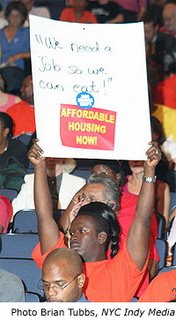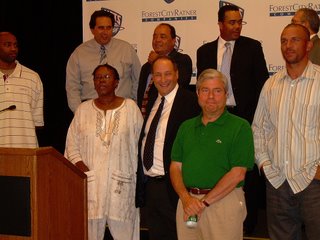Gather up the press and blog coverage, maybe add some video, and you can approximate the experience of the seven-hour public hearing Wednesday on the Atlantic Yards Draft Environmental Impact Statement (DEIS). But it really needed a writer with more "voice,” a columnist like Jimmy Breslin or Murray Kempton (R.I.P.).
Why didn’t a metro columnist, or even a sports columnist, from one of the dailies cross the river? After all, it was the day’s—maybe the summer’s--most striking piece of street theater. There were so many threads to follow, building blocks for 800 compelling words, stories with drama and maybe even a moral.
 What about all the poor people bused in or organized by BUILD and ACORN, groups that have been paid by developer Forest City Ratner or received donations from them? How does “We need a job so we can eat?” compete with the reality of the relatively few jobs—especially low-skilled ones—the project would produce? (Ditto for the affordable housing.) And how much is their need and pain ignored by our press and politicians?
What about all the poor people bused in or organized by BUILD and ACORN, groups that have been paid by developer Forest City Ratner or received donations from them? How does “We need a job so we can eat?” compete with the reality of the relatively few jobs—especially low-skilled ones—the project would produce? (Ditto for the affordable housing.) And how much is their need and pain ignored by our press and politicians?
How many working people, pro and con, who showed up at 5 pm or 6 pm were unable to get in the door because busloads of people organized by Community Benefits Agreement signatories got there first? How many people who spoke in favor of the project were part of groups that have been supported by Forest City Ratner? (How many weren’t? And did the developer pay for the buses, just as it did the lunches?)
What about the construction workers? They want the project, bad, and who can blame them--so many projects in New York are built without union labor. Then again, how many of them were taking up seats from Brooklynites who had questions and doubts about the DEIS? And how many jobs are there, after all?
 What about politicians like Borough President Marty Markowitz (in green shirt) and City Councilman David Yassky? They both support the project as long as changes are made, but still won’t specify how much the project should be reduced. Pragmatism or pusillanimity?
What about politicians like Borough President Marty Markowitz (in green shirt) and City Councilman David Yassky? They both support the project as long as changes are made, but still won’t specify how much the project should be reduced. Pragmatism or pusillanimity?
Today Marty was the subject of follow-up in the Times, which still didn’t press him on the density issue. (I had asked how he felt about presiding over a project that would be the densest census tract, by a factor of two, in the country. “I don’t know if it’s true,” he responded, “but I know we need the housing very much.”)
 What about the use of children as props, those kids in their Nets jerseys and their “In My Backyard” stickers? Did their halting statements at the mike contribute much to the hearing? (Had some children who opposed the project took the stand, it would've been equally questionable.)
What about the use of children as props, those kids in their Nets jerseys and their “In My Backyard” stickers? Did their halting statements at the mike contribute much to the hearing? (Had some children who opposed the project took the stand, it would've been equally questionable.)
What about the regular invocation of ghetto authenticity, as if the project—and Brooklyn—were a rap album rather than a $4.2 billion development of mostly luxury housing? To what degree do such claims distract from the complicated DEIS?
Oh, and for some of the Atlantic Yards opponents, to what degree does sinking to the level of some of your antagonists (they booed City Councilwoman Tish James when she brought up children's asthma) damage your credibility? Does heckling Assemblyman Roger Green--who can dig himself his own hole easily enough--when he’s acknowledging the need for compromise represent a wise strategy?
Where was the columnist who'd been through the civil rights movement, or the police brutality protests of the 1980s, who could comment on the remarkable journey of the Rev. Herbert Daughtry? Once on the outside but now on the inside, Daughtry for three minutes turned the Klitgord Auditorium into a thunderous preaching chamber, declaring the Atlantic Yards project almost a civil rights landmark. [Update: it was nearly six minutes.]
And what about the people who spoke too late for the cameras, like Robert Yaro of the Regional Plan Association, whose complicated testimony deserved notice, or the Brooklyn guy who did some vital research on noise but never got to the podium at all?
Was this democracy, or demagoguery? And to what degree was it an example, as I’ve pointed out, of playwright August Wilson’s description of an inner city development deal: I don't care if somebody else makes some money 'cause of a tax break. I get mine and they get theirs.
The stories remain to be told.
Why didn’t a metro columnist, or even a sports columnist, from one of the dailies cross the river? After all, it was the day’s—maybe the summer’s--most striking piece of street theater. There were so many threads to follow, building blocks for 800 compelling words, stories with drama and maybe even a moral.
 What about all the poor people bused in or organized by BUILD and ACORN, groups that have been paid by developer Forest City Ratner or received donations from them? How does “We need a job so we can eat?” compete with the reality of the relatively few jobs—especially low-skilled ones—the project would produce? (Ditto for the affordable housing.) And how much is their need and pain ignored by our press and politicians?
What about all the poor people bused in or organized by BUILD and ACORN, groups that have been paid by developer Forest City Ratner or received donations from them? How does “We need a job so we can eat?” compete with the reality of the relatively few jobs—especially low-skilled ones—the project would produce? (Ditto for the affordable housing.) And how much is their need and pain ignored by our press and politicians?How many working people, pro and con, who showed up at 5 pm or 6 pm were unable to get in the door because busloads of people organized by Community Benefits Agreement signatories got there first? How many people who spoke in favor of the project were part of groups that have been supported by Forest City Ratner? (How many weren’t? And did the developer pay for the buses, just as it did the lunches?)
What about the construction workers? They want the project, bad, and who can blame them--so many projects in New York are built without union labor. Then again, how many of them were taking up seats from Brooklynites who had questions and doubts about the DEIS? And how many jobs are there, after all?
 What about politicians like Borough President Marty Markowitz (in green shirt) and City Councilman David Yassky? They both support the project as long as changes are made, but still won’t specify how much the project should be reduced. Pragmatism or pusillanimity?
What about politicians like Borough President Marty Markowitz (in green shirt) and City Councilman David Yassky? They both support the project as long as changes are made, but still won’t specify how much the project should be reduced. Pragmatism or pusillanimity? Today Marty was the subject of follow-up in the Times, which still didn’t press him on the density issue. (I had asked how he felt about presiding over a project that would be the densest census tract, by a factor of two, in the country. “I don’t know if it’s true,” he responded, “but I know we need the housing very much.”)
 What about the use of children as props, those kids in their Nets jerseys and their “In My Backyard” stickers? Did their halting statements at the mike contribute much to the hearing? (Had some children who opposed the project took the stand, it would've been equally questionable.)
What about the use of children as props, those kids in their Nets jerseys and their “In My Backyard” stickers? Did their halting statements at the mike contribute much to the hearing? (Had some children who opposed the project took the stand, it would've been equally questionable.)What about the regular invocation of ghetto authenticity, as if the project—and Brooklyn—were a rap album rather than a $4.2 billion development of mostly luxury housing? To what degree do such claims distract from the complicated DEIS?
Oh, and for some of the Atlantic Yards opponents, to what degree does sinking to the level of some of your antagonists (they booed City Councilwoman Tish James when she brought up children's asthma) damage your credibility? Does heckling Assemblyman Roger Green--who can dig himself his own hole easily enough--when he’s acknowledging the need for compromise represent a wise strategy?
Where was the columnist who'd been through the civil rights movement, or the police brutality protests of the 1980s, who could comment on the remarkable journey of the Rev. Herbert Daughtry? Once on the outside but now on the inside, Daughtry for three minutes turned the Klitgord Auditorium into a thunderous preaching chamber, declaring the Atlantic Yards project almost a civil rights landmark. [Update: it was nearly six minutes.]
And what about the people who spoke too late for the cameras, like Robert Yaro of the Regional Plan Association, whose complicated testimony deserved notice, or the Brooklyn guy who did some vital research on noise but never got to the podium at all?
Was this democracy, or demagoguery? And to what degree was it an example, as I’ve pointed out, of playwright August Wilson’s description of an inner city development deal: I don't care if somebody else makes some money 'cause of a tax break. I get mine and they get theirs.
The stories remain to be told.
Which major development in New York should citizens have stopped because its construction and existence would disrupt the lives of some local citizens?
ReplyDeleteHow about the subway? The cut & cover construction killed a lot of businesses.
The Verrazano Bridge? Gay Talese wrote a fabulous piece about the impact of its construction.
The Empire State Building? It's about three times the height of all the other buildings in its part of town.
Lincoln Center? The city could still be home to the real life Jets and Sharks and the slum housing formerly defining that neighborhood.
The United Nations? Well, that's a tough one. But I don't believe anyone would like to see the area return to its former state of despair.
The World Trade Center? Its outrageous proportions became a NYC icon. The city spent years clearing out people and businesses from the site. Meanwhile, the replacement for the twin towers is even taller.